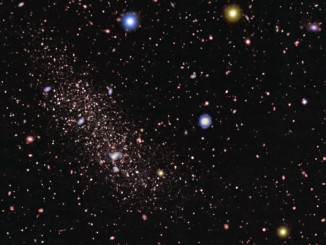
It is not unusual to find hot winds blowing from the swirling discs of material around supermassive black holes at the centre of active galaxies.
If powerful enough, these winds can influence their surroundings in various ways. Their primary effect is to sweep away reservoirs of gas that might otherwise have formed stars, but it is also possible that they might trigger the collapse of some clouds to form stars.
Such processes are thought to play a fundamental role in galaxies and black holes throughout the universe’s 13.8 billion years.
But they were thought to affect only the largest objects, such as massive elliptical galaxies formed through the dramatic collision and merging of two or more galaxies, which sometimes trigger the winds powerful enough to influence star formation.
Now, for the first time, these winds have been seen in a more normal kind of active galaxy known as a Seyfert, which does not appear to have undergone any merging.
When observed in visible light, almost all Seyfert galaxies have a spiral shape similar to our own Milky Way. However, unlike the Milky Way, Seyferts have bright cores that shine across the entire electromagnetic spectrum, a sign that the supermassive black holes at their centres are not idle but are devouring their surroundings.
XMM-Newton has found that the winds from around the black hole are moving at 23,000–33,000 kilometres per second, about 10 percent the speed of light.
An important finding is that the wind from the centre is sufficiently energetic to heat the gas in the galaxy and suppress star formation — the first time it has been seen in a relatively normal spiral galaxy.
“It’s the first solid case of an ultra-fast X-ray outflow observed in a ‘normal’ Seyfert galaxy,” says Anna Lia Longinotti from the Instituto Nacional de Astrofísica, Óptica y Electrónica of Puebla, Mexico, lead author of the paper describing the results in Astrophysical Journal Letters.
The galaxy has another surprise: the X-ray emission from the fast winds from galactic cores are usually dominated by iron atoms with many of their electrons stripped off, but this galaxy’s winds turn out to be rather unusual, exhibiting lighter elements like oxygen, with no iron detected.
“I was actually very surprised to discover that this wind is made mostly of oxygen because nobody has seen a galaxy like this before,” says Anna Lia.



